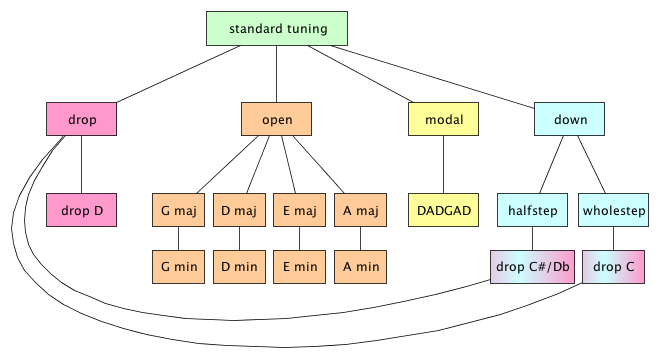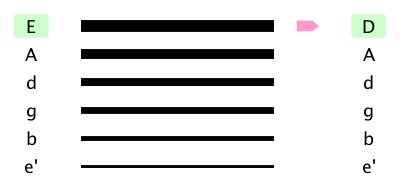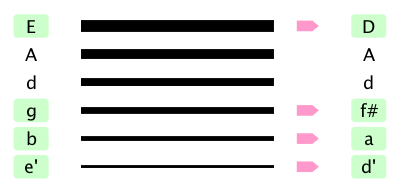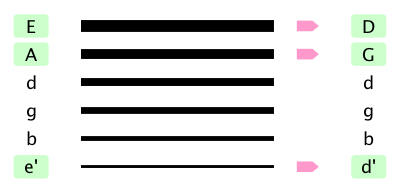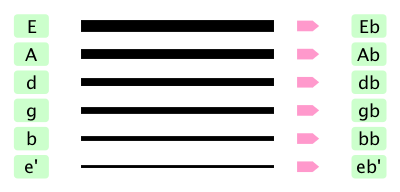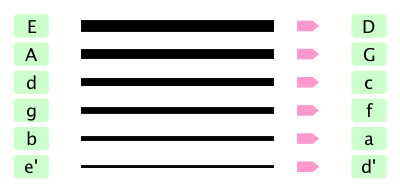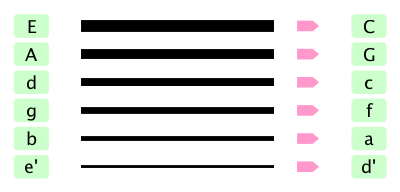Table of Contents
Standard Tuning
Surely you still remember how the strings of your guitar are tuned, right?
Exactly: E – A – D – G – B – E, from top to bottom, from low to high.
This is called the standard tuning.
Tuning is how the strings of a guitar are tuned and tunings in general are the variation / deviation from the standard tuning.
Why do you do that? Why change the standard tuning?
There are a lot of reasons for that:
- You can play some chords in different tunings more easily (see drop tunings)
- It sounds interesting, because you almost automatically play extended chords (see modal tunings)
- It sounds heavier, fatter (see drop / down tunings)
- Some tunings make the songs easier for the singer to sing (see down tunings)
- You can use tools like bottlenecks more easily (see open tunings)
Basic Math
Because you can tune every string to 12 different notes independently you could end up with 12^6 = 2,985,984 different tunings. Whosh!
But are they all useful? I guess not! So I will walk You through some basic alternate tunings which have practical use.
First, a small picture for the overview
I roughly divide the tunings according to which or how many strings are tuned differently to standard tuning.
Drop-Tuning
If you are new to tunings, start with a drop tuning: Usually the low E-string is tuned a whole step down to D, which is then called Drop-D:
An advantage of this tuning is that you can grab power chords with just one finger, because the lower open strings D – A – D already represent the D – powerchord.
You can now change the powerchords extremely fast. This tuning became popular with the advent of NuMetal but has been used since the Beatles.
Songs which use Drop-D
Just some of my favorites
- Soundgarden – Spoon Man
- Foo Fighters – Everlong
- Rage against the Machine – Killing in the name of
Open-Tuning
In an open-tuning, all empty strings played together already form a chord, so you can put the finger on a chord or a bottleneck over all strings and move the chord around.
In an open-tuning you primarily have to decide, if you want to hear a minor or major chord.
Open D major
When your guitar is already in Drop-D you can alter the lower three strings to get to Open D major: turn the g string to f#, the b string to a and the high e string to d.
Songs in D major
- Reo Speedwagon – Time For Me To Fly Tab
- Bob Dylan – Buckets of Rain
G major
An example for usage of this tuning is Brown Sugar by The Rolling Stones
Some other open tunings
D minor: D – A – D – F – A – D
G minor: D – G – D – G – Bb – D
A major E – A – E – A – C#- E
A minor E – A – E – A – C – E
E major E – B – E – G#- B – E
E minor E – B – E – G – B – E
Theoretically, there are more tunings, but you have to be careful because of the string pattern: the strings can not be tuned arbitrarily high, because they tear otherwise and also not arbitrarily deep, because they then schlabbern!
Bottlenecks
A short list of my favorite Bottlenecks (Thomann Affiliate Links)
Fender Glass Slide Standard Large
Fender Brass Slide Stand Medium
Harley Benton Bottleneck/Slides Set Metal
Modal Tunings
Out of all modal tunings especially the DADGAD should be emphasized. Not least because Led Zeppelin’s Kashmir is played in this tuning and had the true commercial success with the cover version “Come with me” by Puff Daddy.
There is even a perfect tuning for me called D – A – D – D – A – D!
Down Tuning
As down tuning, I refer to tunings where all strings are tuned down by the same number of semitones. Most common in rock and heavy metal are down tunings by a semitone step
One good example are Guns’n’Roses, they’ve used this tuning all over their songs since their debut Appetite for Destruction.
In harder / modern styles of the metal, e.g. metalcore guitars are tuned down by a whole tone or even more.
Combinations
You can of course always add a dropped E string to your down tuned guitar as well.
At Excess Pressure we use to tune down a half tone to Eb/D# and drop the Eb to a Db/C#. You can call this Drop-C#
One of my favorite bands Killswitch Engage uses a whole step down plus drop tuning called Drop-C
My friend Daniel uses a Drop-B on his six string: B F# B E G# C#
It is highly recommend to use heavier strings when tuning down that much.
I’ve used the D’addario EXL117 on my six string guitar for a Drop-B tuning.
But you can of course use a seven string set like Daddario EXL110-7
and leave out the high e string.
If you want to go even deeper, buy a 7-string guitar or pick up a baritone guitar, as the deepest string is already tuned to H or A
But again you can tune or drop down again 🙂
Resources
I’ve found a nice website where you can search what song was played in which tuning: Guitar Tuning Database

